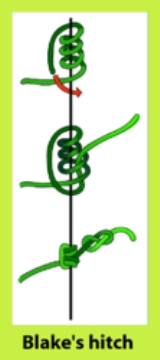
Blake's hitch
Encyclopedia
The Blake's Hitch is a friction hitch
commonly used by arborist
s and tree climbers as an ascending knot. Unlike other common climbing hitches, which often use a loop of cord, the Blake's hitch is formed using the end of a rope. Although it is a stable knot, it is often backed up with a stopper knot
, such as a figure-of-eight knot, for safety. It is used for both ascending and descending, and is preferred by many arborists over other hitches, such as the taut-line hitch
, as it is less prone to binding.
guides periodical in 1981; in 1990, he presented it in a caving
journal, Nylon Highway.
Separately, Jason Blake discovered the knot for himself and presented it to the arborist community
in a letter to Arbor Age in 1994, after which it was enthusiastically adopted by arborists. It has since become well
known under the name "Blake's Hitch".
only under two; if the hitching line has trouble gripping because it is relatively stiff, an extra turn should be made and the end tucked under it (which gives more thickness for the stiff rope to compress).
Friction hitch
A friction hitch is a kind of knot used to attach one rope to another in a way that is easily adjusted. These knots are commonly used in Single Rope Technique while climbing to ascend a hanging rope by alternately hanging on one friction hitch and sliding the other up...
commonly used by arborist
Arborist
An arborist, or arboriculturist, is a professional in the practice of arboriculture, which is the cultivation, management, and study of individual trees, shrubs, vines, and other perennial woody plants...
s and tree climbers as an ascending knot. Unlike other common climbing hitches, which often use a loop of cord, the Blake's hitch is formed using the end of a rope. Although it is a stable knot, it is often backed up with a stopper knot
Stopper (knot)
The term stopper knot has three distinct meanings in the context of knotting and cordage.-At the end of a line:A stopper knot is tied at the end of a rope to prevent the end from unraveling, slipping through another knot, or passing back through a hole, block, or belay/rappel device...
, such as a figure-of-eight knot, for safety. It is used for both ascending and descending, and is preferred by many arborists over other hitches, such as the taut-line hitch
Taut-line hitch
The taut-line hitch is an adjustable loop knot for use on lines under tension. It is useful when the length of a line will need to be periodically adjusted in order to maintain tension. It is made by tying a rolling hitch around the standing part after passing around an anchor object...
, as it is less prone to binding.
History
The first known presentation of this knot was made by Heinz Prohaska in an Austrianguides periodical in 1981; in 1990, he presented it in a caving
Caving
Caving—also occasionally known as spelunking in the United States and potholing in the United Kingdom—is the recreational pastime of exploring wild cave systems...
journal, Nylon Highway.
Separately, Jason Blake discovered the knot for himself and presented it to the arborist community
in a letter to Arbor Age in 1994, after which it was enthusiastically adopted by arborists. It has since become well
known under the name "Blake's Hitch".
Usage
If the hitch does not hold securely due to slickness of the standing line, an extra turn should be made around the line, with the end still tuckedonly under two; if the hitching line has trouble gripping because it is relatively stiff, an extra turn should be made and the end tucked under it (which gives more thickness for the stiff rope to compress).

